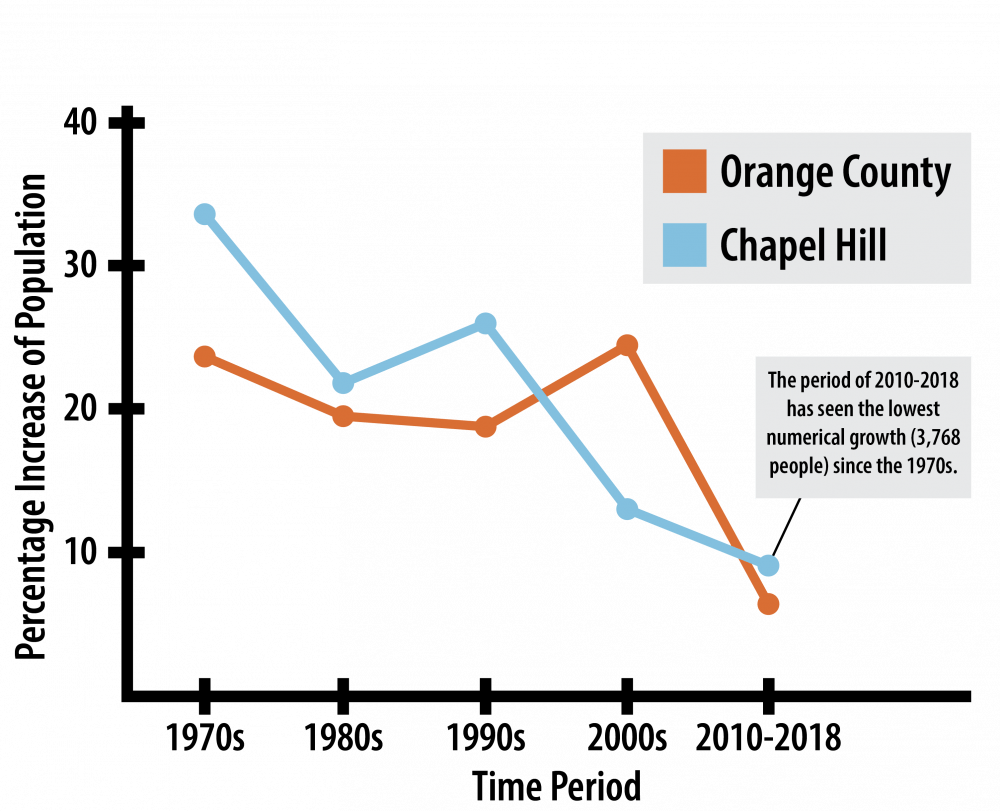“If you look at the graphs from the Chapel Hill-Carrboro Chamber report, you’ll see that Chatham County has had pretty high growth for the last three decades. It’s also declined for the 2010s, but it is significantly higher than Orange County’s,” Stanford said.
Orange County still added more residents numerically than Chatham County, and both counties are growing faster than the state average.
Since 1987, Chapel Hill, Carrboro and Orange County have employed a Rural Buffer “to maintain rural character and low-density residential uses.” In Chapel Hill, the buffer prevents urban development to expand outside of a prescribed area of 20.9 square miles.
While the numbers alone may seem concerning, digging deeper into what has caused slow growth and what it means for Chapel Hill’s future development is more nuanced.
Balancing housing needs
Matt Gladdek, executive director of the Chapel Hill Downtown Partnership, said many cities and towns in the Triangle area are running out of easy-to-develop land.
“We now have to confront some really difficult decisions,” Gladdek said. “You can either cut down forests, specifically Chapel Hill, which is, rightfully so, a very sensitive conversation, especially in this era of climate change as we are trying to minimize our impact on the Earth. We can cut down farmlands, we can knock down current housing and build higher or we can say that we’re full, and we can’t fit any more people in Chapel Hill.”
Gladdek said town policy has made it difficult to develop, and because of a lot of attractive aspects of living in Chapel Hill, competition and costs are increasing.
Nancy Oates, a Chapel Hill Town Council member, said she is concerned more people are choosing to live in neighboring counties and commute to Chapel Hill for work.
“From my experience, the healthiest towns are the ones where people stay invested in the town. If they work here, they are able to live here, and if they live here, they’re able to work here,” Oates said. “So it concerns me that we may start to see more of a commuter mentality.”
Oates said she did not think space constraints were necessarily the cause of rising housing prices but did say the town focusing on one type of housing is a disservice.
“If we only have one type of housing, we’re only going to attract one sort of demographic: people who can afford that apartment and people who want to live the apartment-living type of life,” Oates said.
To get the day's news and headlines in your inbox each morning, sign up for our email newsletters.
She said a possible way to preserve space and attract families is to have more cluster developments, which are more densely populated than traditional subdivisions but are still single-family homes.
Aaron Nelson, the president and CEO of the Chapel Hill-Carrboro Chamber of Commerce said the town is re-evaluating its land-use policy in ways that will create housing developments, and also said there is a need for different types of housing such as townhomes, condos and apartments.
Chapel Hill Town Council member Hongbin Gu said Chapel Hill has always been an expensive town as far as the cost of housing, but said there are also other cost-of-living factors, such as transportation, where Chapel Hill is far more affordable than its peers. She and Oates both mentioned that affordable housing is a nationwide issue not specific to Chapel Hill.
'We are going to need to grow'
Gu said the overall slowdown in population growth doesn’t concern her, but what does is who is moving away from Chapel Hill.
“Chapel Hill is a college town, so we have lots of undergraduates, we’re constantly getting a fresh supply of undergraduates every year, so we have a large inflow of young people,” Gu said. “But after their graduation, they all leave because there are no job opportunities for them to stay here.”
The report shows that in Orange County, net migration from people aged approximately 25-35 is negative, meaning there is a net outflow of people in this age range from the county.
Gu’s other main concern is that the town needs to expand its tax base, as town government expenditures are rising while revenue is remaining much flatter.
The largest portion of the town's revenue comes from property taxes, specifically from residential properties, because the major employer is the University, which does not pay property taxes to the town like other private businesses.
Gu said to change both of these trends, the town needs to attract more businesses and create other opportunities for employment outside of UNC, so it's not overwhelmingly reliant on residential taxes.
Gladdek from the downtown partnership said extensive surface parking in Chapel Hill has pushed some commercial opportunities like Wal-Mart outside of downtown Chapel Hill and is not an efficient use of land. Gu said more robust municipal and regional transportation can be another way to address this and attract both business and residents.
Gladdek said the downtown partnership is beginning to talk to the town and UNC about creating a master plan for downtown Chapel Hill and to collect proposals that would bring in more businesses.
Nelson pointed out that overall job growth is, in fact, outpacing population growth.
“I do think that we are going to need to grow our population to meet the needs of local employers, like the University and the hospital,” Nelson said, adding that if more people end up commuting from other places into Chapel Hill for work, traffic could increase.
“I’m confident that we can meet the infrastructure needs and the transportation needs of a growing population,” Nelson said.
city@dailytarheel.com



